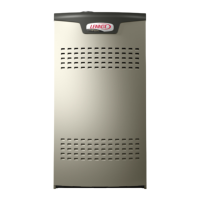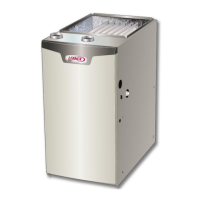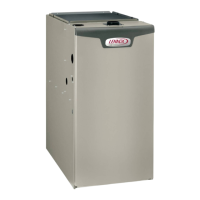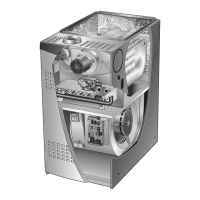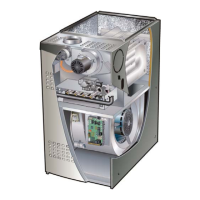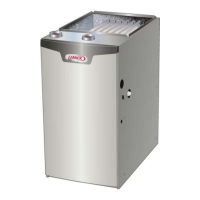Page 15
Table 8
Burner Specifications
Unit
Burner
Number
Beckett
Spec. No.
Beckett
Air Tube
Part No.
Input
Rating
BTU/HR
Nozzle Size,
Spray, Angle, &
Pattern
Pump
Pressure
Head
Insertion
Length
Static
Plate
Diameter
ELO183UF68/86 100195−08 ARM1812 AF46XTHS 68,000
0.50 80 A
HOLLOW
100 F0 4.75 2.75
ELO183UF68/86 100195−08 ARM1812 AF46XZTHS 86,000
0.50 80 A
HOLLOW
100 F0 4.75 2.75
ELO183UF101/114 100195−09 ARM1813 AF46XNHS 101,000
0.65 B
SOLID
140 F3 4.75 2.75
ELO183UF101/114 100195−09 ARM1813 AF46XNHS 114,000
*0.65 80
SOLID
140 F3 4.75 2.75
ELO183UF135/150 100195−07 ARM1811 AF46WPHS 135,000
0.85 80 B
SOLID
140 F4 4.75 3.38
ELO183UF135/150 100591−07 ARM1811 AF46WPHS 150,000
*0.85 80 B
SOLID
140 F4 4.75 3.38
*Nozzle must be field−installed for conversion to higher heating input.
NOTE − All nozzles are Delavan brand.
Fan Delay
Fan on time is 1 to 30 seconds and non adjustable. Fan off
time is 60 to 120 seconds and non adjustabe.
Limit Control
Limit Control Do not adjust from factory setting.
Burner Adjustment
The following instructions are essential to the proper op-
eration of ELO183UF series oil furnaces. To prevent soot-
ing, these instructions must be followed in sequence:
1. DraftThis test should be taken at the breach be-
tween the outlet of the vent connector and the baro-
metric draft control. Generally a 1/4" hole will need to
be drilled for the draft gauge to be inserted into the vent
connector.
A minimum of 0.03 draft must be established without
the burner in operation. With the burner in operation,
the draft should be 0.04 to 0.05. This is VERY critical to
the flame retention head burners.
Oil furnace installations also require careful inspection
to make sure the chimney is in good shape and can ac-
commodate the products of combustion. The tempera-
ture in the unconditioned space will also affect the draft
if long vent connectors are allowed to get too cold.
2. Overfire DraftThis test should be taken with the
burner in operation. Remove the plug from the center
of the inspection port. Insert your draft gauge into the
hole.
A reading of the overfire draft should be 0.02 less than
the reading found in the vent connector. If a positive
reading is seen at this point, the combustion fan is
pumping too much air into the heat exchanger. Make
the necessary adjustments with the air shutter or air
band.
3. Smoke TestThe smoke test should be taken at the
hole drilled in step 1.
Using a smoke test gun, adjust the air so that you will
have just a trace (between 0 and #1) of smoke. If the
burner is producing more than #1 smoke, adjust the air
shutter (primary) and air band (secondary) to reduce
the smoke. See figure 15. To adjust the air shutter,
loosen the top screw on the air shutter (and lower
screw, if necessary). Then, rotate the shutter until the
desired smoke level is achieved. If smoke cannot be
reduced to the desired level by moving the air shutter,
adjust the air band to increase the air. To adjust the air
band, loosen the air band screw and rotate the
band.This is the starting point. Do not stop here.
Air Band
(Secondary)
Air Shutter / Band Adjustment
Loosen this screw
to adjust air band.
Air Shutter
Air Band
Figure 15
4. CO
2
TestAgain, take this sample at the vent pipe.
With the unit firing at a trace of smoke, take a sample of
the CO
2
. From the results of this test, a window of op-
eration" will be determined. This window of operation
establishes some tolerance. The tolerance the installer
builds in provides room within the set-up for those
things which might affect combustion. Those things
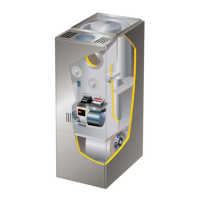
